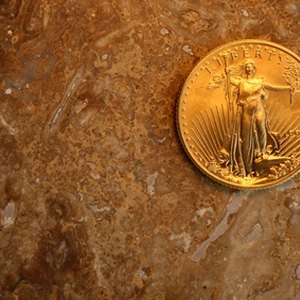
Issued in one ounce, half-ounce, quarter-ounce and tenth-ounce sizes, gold eagles (or more accurately American Eagle Gold Coins) are 22 karat (.916 fine) coins struck at the West Point Mint and forged from gold mined in the United States. They are available in three formats: bullion, proof and (since 2006) uncirculated. Since their introduction in 1986, gold eagles have been a hit with investors, with over 13 million of the one-ounce bullion coin being distributed as of November 2010. Gold-plated reproduction eagles have appeared on Internet auction sites, but collectors should have little difficulty in distinguishing these from the genuine article.
Examine the coin to see if it has the word “copy” stamped upon it in tiny letters. This appears on the more honest of the reproductions.
Use a jeweler's loupe to scrutinize the design (Liberty striding forward, by Augustus Saint-Gaudens, the same image that appeared on the double eagle of 1907). Liberty's gown and hair should be crisply realized, especially on the proof and uncirculated coins, which are made with multiple strikes to achieve a meticulous finish. No gold-plated reproduction can hold that degree of detail.
Weigh the coin on a pair of digital scales. Every gold eagle bears a denomination expressed as weight in ounces. Make sure that the denomination and the actual weight match up. On fakes, they won't.
Look carefully at the accompanying documentation and packaging. Proof and uncirculated gold eagles should be sealed within plastic capsules mounted in satin-lined velvet presentation cases. Each has a certificate of authenticity. The only avenue for bullion gold eagles to be sold to the public is through an authorized dealer. Check if the current owner is such an authorized person, or has a bill of sale from one.
References
Writer Bio
Based in the United Kingdom, Graham Rix has been writing on the arts, antiquing and other enthusiasms since 1987. He has been published in “The Observer” and “Cosmopolitan.” Rix holds a Master of Arts degree in English from Magdalen College, Oxford.

